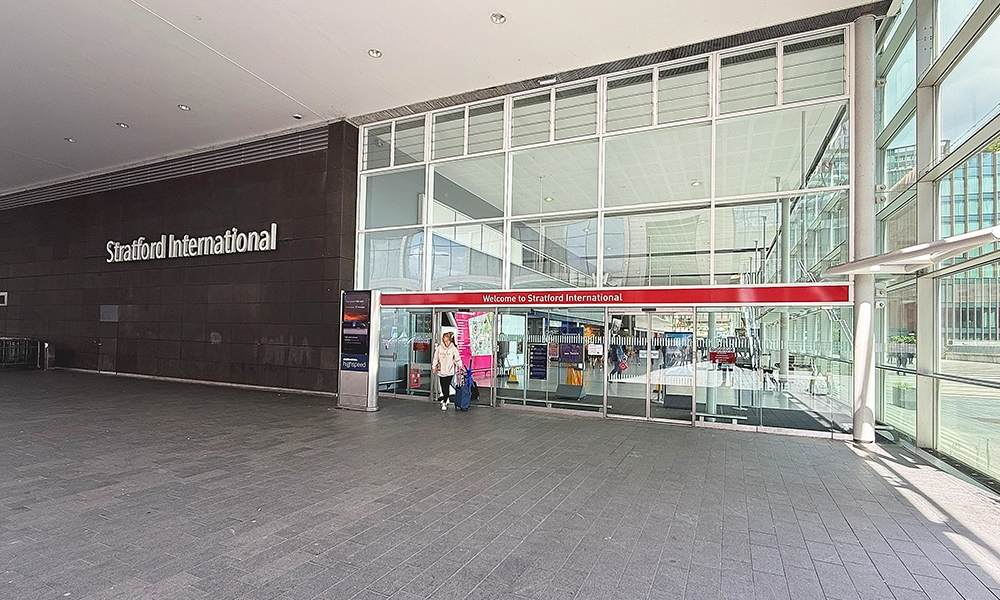We catch up with the company’s CEO, Adrian Quine, on its ambition to run services to Paris and Brussels from Stratford International in east London

Subscribe to our free Wharf Whispers newsletter here
Could Stratford International station finally live up to its name?
Plans for Eurostar services to stop in east London never came to fruition and no other operator has thus far come in to offer overseas destinations to passengers.
However, all that could be about to change thanks to an EU directive which aims to ensure equal access to tracks and stations for third parties looking to run services.
While this doesn’t alter the state of play in the UK, it does apply to routes across the continent, including infrastructure in France owned by state operator SNCF, which runs Eurostar – the only company running international services from Britain.
The change in European law, as well as a relaxation of the rules around what kind of trains can run through the Channel Tunnel, have paved the way for new ideas – something that has long been the foundation of the regeneration of east London.
Enter Gemini Trains – a company led by chair Lord Tony Berkeley, public affairs manager of Eurotunnel during the undersea link’s construction and a former chair of the Rail Freight Group, and CEO Adrian Quine, a journalist, broadcaster and co-founder of Alliance Rail Holdings.
Having recently signed a co-branding partnership with Uber, the firm wants to run trains from Stratford International to Paris and Brussels.

Gemini Trains’ proposition
“We’ve spent two years modelling new services through the Channel Tunnel to see where the opportunities are – looking at stations that haven’t been used, have been mothballed or, in the case of Stratford, were never used for international services,” said Adrian.
“With all the growth in east London it seemed sensible to look at creating something a bit new rather than trying to emulate what’s already at St Pancras.
“Stratford itself is now the second busiest station in Britain with the Elizabeth Line plus the DLR, Jubilee, Central and Overground making it the most connected in London.
“It’s a hugely important area and it’s where the growth is – you see all these businesses moving east and we feel there’s a great opportunity.
“Stratford International is also a bit of a blank canvas for us.
“It’s easier to manage than St Pancras, which has major issues in boarding at the lower level, although these are now being addressed.
“That’s why we’ve commissioned an architects’ report – a full feasibility study to look at how we can manage the passenger flow because Stratford International was originally designed as an intermediate station and not as a terminus.
“We believe Stratford is definitely achievable but we need to wait for the report to confirm the station can cope with 500 passengers – you couldn’t, for example, operate with a single escalator with that number of people, so we have to be sure.”

room to grow
Gemini says its plans fit with capacity already available on the high speed tracks that go under the English Channel.
Its proposal – to launch in 2029 – was further buoyed by a report from the Office Of Rail And Road (ORR), which said on June 5, 2025, that Temple Mills International Depot (TMI) had capacity for either Eurostar to grow its operations at the site or for another company to come in alongside it at the facility.
ORR is now inviting Eurostar and other companies to provide details of their plans so it can decide what will happen at TMI.
“The growing appetite to provide international rail services is great news for passengers,” said Martin Jones, deputy director, access and international at ORR.
“We now need operators to set out more detail on their proposals at pace, and will work quickly and as thoroughly as possible to determine the best use of capacity at TMI.”

an east London connection
For Gemini, the case for Stratford International is about offering something different to Eurostar – an alternative way to travel overseas out of London and at a lower cost, primarily coaxing passengers off aeroplanes to travel into Europe.
“I do draw parallels with London City Airport,” said Adrian.
“There you have a small operation, more manageable than Heathrow, Gatwick or Stansted.
“It’s a pleasure to fly from, because it’s well organised – we really want to get Stratford International to work along similar lines.
“We’re absolutely looking to offer cheaper fares too.
“We’ve modelled our business on a high utilisation of the rolling stock, which means the trains will do more trips per day and we can get our seat price down.
“The trains will be carrying more passengers so we can pass that saving on to travellers.
“We think this will create a market shift, particularly from aviation.
“We’re not trying to poach passengers from Eurostar – they are often overbooked and full on most trains in any case.
“We think that the capacity isn’t there on these routes at the moment but the demand is – people are currently flying because they can’t get an affordable train fare unless they book far in advance.”
Adrian said Gemini’s plans would also benefit the local area, with the services attractive for residents and pulling in travellers to boost business.
Gemini Trains – a catalyst for regeneration?
“While Stratford International is not physically linked directly to the main station, it’s only a short walk and the DLR connects the two as well,” he said.
“Some passengers will wish to walk through Westfield Stratford City if they feel they have time.
“As soon as the feasibility report comes back, we’ll be looking to engage with local people and organisations.
“This could be a massive growth opportunity for east London.”
Ultimately the ORR will be responsible for deciding which operator gets access to the line, thus deciding the fate for Gemini and Uber’s plans.
There are competing operations.
Perhaps the regulator, however, will heed the words of politicians and companies down the years who have all called for Stratford International to fulfil its intended purpose as a way of supercharging the growth and prosperity of an area that’s already driving east London regeneration.
Find out more about the company’s plans here
Read more: Brother Marcus opens its doors in Canary Wharf



